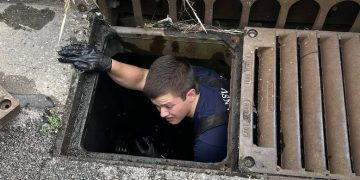As the big righty Aaron Slegers made his 2020 debut with the Rays, Rick Knapp was glued to the television. Anxious on every pitch. Like it was his own son.
And it’s not like the Durham Bulls’ pitching coach has even known Slegers that long. They weren’t acquainted until the 6-foot-10 hurler first arrived to the Bulls’ clubhouse in 2019, this massively intriguing prospect ducking his head under the door. It was another kind of impression, though, that put a soft spot in his coach’s heart.
“This guy is a different kind of cat,” Knapp said. “Very accountable. Works his tail off.”
So Knapp had the TV on in Port Charlotte, Fla., when Slegers took the mound Aug. 12 in Fenway Park. Those first two innings versus Boston, nothing but joy. Scoreless ball. The third inning, however, was nothing but pain.
“You have to be (crapping) me,” Knapp thought, as four singles just barely eluded the Rays’ infield. Four in a row.
“How many balls can find a hole? And then, kaboom.”
Home run, J.D. Martinez. Tzu-Wei Lin proceeded to tag Slegers for one more single, one more grain of salt in the wound. All told, it went down as two innings pitched, seven hits, and five earned runs for one of Knapp’s all-time favorite proteges. Just cruel. But if anyone was capable of working through the pain, it was Slegers.
In high school, Slegers grew so quickly, it hurt to pitch at times. He never earned a varsity letter. He was so under the radar as a recruit, he walked on at IU. Then, a come-backer broke his wrist just one inning into his freshman year.
He rose up, all the way up to Big Ten pitcher of the year and Twins fifth-round pick. But he never lost his even keel.
“The road is paved with so much failure and hardship and questioning your own beliefs,” Slegers said, “and I’m so grateful for my own experiences of never being the best player in the state, never being the best player in the world, never having anything come too easy to me in my amateur career. That really laid the groundwork. That gave me all the tools I needed to get through the last three or four years.”
The last few years, Slegers has been up and down. Waived by the Twins. Picked up briefly by the Pirates. Purchased by the Rays. Like any player bounced from the majors and relegated to the minors, Slegers had to wonder what was becoming of his life. If he needed to get a real job.
But this is a pitcher with a history of turning setbacks into big steps forward. And the Rays seemed to know that. Four days after the Boston blowup, they let Slegers pitch the final inning of a 7-5 win over the Blue Jays. He sat down the middle of their order, in order, for his first save.
Teoscar Hernandez, groundout. Rowdy Tellez, strikeout. Vladimir Guerrero Jr., groundout. From that game on, Slegers strung together eight scoreless innings of relief.
“That was a big moment of just ‘You can pitch here,’” Slegers said. “You’re not a mop-up guy in the Big Leagues. You’re not this garbage-innings reliever. You can pitch in the biggest, most high-leverage situations in the Big Leagues and you’re capable of the moment.”
That’s a belief Slegers had to recapture. In 29 MLB innings over two seasons with the Twins, the results were middling at best. One of Slegers’ biggest fans, Knapp, who has coached for the Detroit Tigers, as well as several farm teams across the league, can easily explain why.
“He was a right-handed sinker-ball pitcher throwing 88 miles per hour,” Knapp said. “You can walk out on campus and find that guy. Four or five of them.”
If Slegers wanted to make it in the majors, he needed to separate himself. And separation itself was the key.
A sinker-baller can succeed in the MLB if he’s not predictable. If all he does is throw sinkers over the plate, hitters will get their barrels under the ball and rip it over the fence. Slegers needed a fastball that could rise up in the zone. He needed a heavy slider to cut across it.
He needed to throw harder, he needed more movement, and if he wanted to stick in the Rays’ system, he needed to do all of that quickly. There was no offseason for Knapp to begin tweaking with the big righty. Throughout the 2019 season in Durham, Knapp was going to make Slegers worse, hoping to eventually build him up better.
Slegers got much worse.
“We tried to get him to throw the ball harder, to get into his legs a little bit more. We tried to do a lot of things in season that you don’t try to do in season … because that takes away from your presence and your competitiveness,” Knapp said. “He kind of got lost in that instead of competing. Not only was his stuff so-so, man, he was competing against himself instead of the hitter.”
That first half of the 2019 season, possibly the worst two- or three-month stretch of his career, forced a “looking in the mirror” moment for Slegers. He had to ask himself how much harder he was willing to work for his pro dreams.
“When you are doing well, you are like I’ll just keep doing what I’m doing,” Slegers said. “When things aren’t going well, it’s ‘What am I doing with my life?’”
Knapp admits it was a “touch-and-go” situation. He wondered if Slegers would get released. Or maybe a stint on the DL would give him a chance to regroup.
Slegers just pressed on. He constantly found Knapp for advice. He was always in the bullpen, refining technique. By the postseason, Slegers was Durham’s best pitcher. His fastball was rising. His sinker was ducking under bats.
The big righty still finished the 2019 season in Durham with a 6-7 record and a 5.05 earned run average. But Slegers was finally on the right track.
“He was the one who took the bull by the horns and said ‘Man, give me the damn ball, and I’m going to pitch, and I’m going to be as good as I can be,’” Knapp said.
The second half of 2019 earned Slegers an invite to Rays’ spring training. But of course, nothing in Slegers’ career has been a straight line.
He will always remember that quick walk into the clubhouse before a scheduled start in March. There was this big, bold headline on TV.
“I’ve still got my cleats on my feet, my jersey on my back, and here’s ESPN, ‘Spring Training Has Been Canceled,’” Slegers said. “I just remember being the last person to pitch in Rays spring training. … I have a very good memory of my past experiences and results of what hitters have done against me. But that day was a blur.
“I just vividly remember the reporter on ESPN. Her face will be ingrained in my mind forever.”
The next morning, the Rays had a meeting where no one really knew what to say. They were all just told to go somewhere comfortable. Slegers went home to Arizona.
There, he worked out with another Hoosier trying to stick in the majors, Giants pitcher Caleb Baragar.
Their crisscrossed paths both arrived at the same destination. Baragar surprisingly made the Giants’ roster out of summer camp. Now the first-year reliever is somehow one of the National League’s leaders in wins, sitting at 5-1. Slegers spent the first couple of weeks of the season in Port Charlotte. But he made it hard for Tampa to keep him there.
His slider, which used to sit at 81 mph, has hit 85. His average pitch velocity, once around 88 mph, has increased to 91. He can touch 93 to 94 on his fastball.
“He never let his guard down. He was frickin’ on it,” Knapp said. “They see his numbers. They have a theorem and an algorithm that will match it up and say ‘This guy’s stuff will be able to help us up here.’ It’s not ‘Knappy says he looks good.’ It doesn’t work that way anymore.”
His appearance versus the Red Sox wasn’t pretty, but luckily it came when the Rays held a nice-sized lead. He ate some innings for Tampa, even if the outing devoured his ERA. It was 22.50 coming out of Boston.
But again, it’s a deceiving number. The “law of large numbers” tells Knapp that four straight singles shouldn’t seep through an infield. After his save versus the Blue Jays, Knapp sent Slegers a congratulatory text. Slegers wrote back, detailing every pitch and why it worked.
It was an odd back-and-forth, though, just because Slegers went from career moment to optioned to the taxi squad. That same day. Baseball is a weird business, and it was really just a paper move, because the Rays needed another body active for a few days. Slegers never left the team.
“Don’t worry about that, man, your stuff is playing really well. Other teams are going to start to notice,” Knapp texted. “Just keep your frickin’ work ethic. Do what you are doing, and positive things are going to happen.
“And he went on a tear after that.”
That next weekend, Slegers was reactivated and continued his streak of scoreless innings. One of his changeups put Yankees slugger Luke Voit on a knee in the batters box. Slegers also pitched 3⅓ frames of one-run ball against the Nationals earlier this week, shrinking his ERA to 4.67.
More than respectable.
“He could be a steal of the century for us,” Knapp said. “He basically came out of nowhere.”
From junior varsity pitcher, to IU walk-on, to the 88-mph sinker-baller who stole a pro pitching coach’s heart. It’s been quite the journey.
Then again, Slegers never planned on a straighter path.
“I never sat down and had the next 12 years of my life mapped out. ‘Even though I’m on JV, I’m going to be a big leaguer.’ No, I just loved playing baseball,” Slegers said. “Every year, it’s just competing and doing the best you can to play baseball for a living. It really is that simple, and it was that simple when I was younger. Even when there was no money attached to it.
“It’s funny how life works out, right? I was blessed with the physical tools of height and strength and an ability to throw strikes. A lot of those are cultivated out of a desire to just keep playing the game I grew up playing.”

















































































